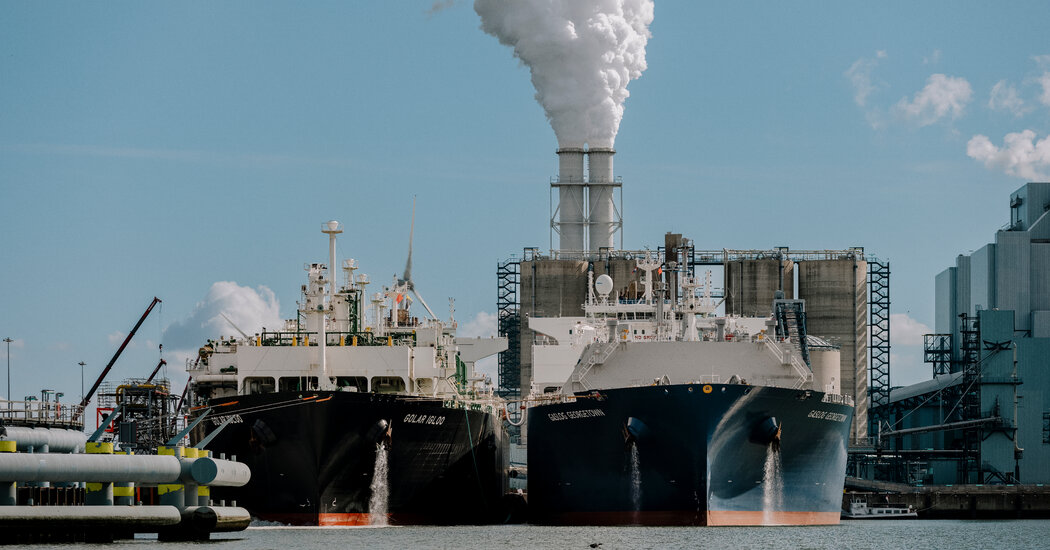European natural gas prices, which soared last year after Russia’s invasion of Ukraine, have now fallen well below pre-war levels, reflecting the continent’s success in finding alternatives to Russian gas, widespread efforts for nature conservation and a relatively mild winter.
But the news comes as Europe’s economy slows — half of the European Union is expected to be in recession next year, the head of the International Monetary Fund, Kristalina Georgieva, said Sunday — and falling gas prices also signal reduced demand for energy.
On Tuesday, the wholesale price for European natural gas, as measured by the Dutch benchmark TTF futures contract for February, sold for about 76 euros per megawatt hour. On the eve of Russia’s attack on its neighbor last February, the contract was sold for around €88.
This is a remarkable turnaround. Just months ago, when Russia curtailed and eventually shut down most fuel exports to Europe, there were intense fears that the continent would run out of gas this winter. That pushed prices to a peak in August of more than €340 per megawatt-hour, about five times the current level.
Those concerns have largely disappeared, even though Russia supplied about 40 percent of Europe’s gas consumption, which is widely used to heat homes, run businesses and generate electricity.
“We now have a well-supplied EU gas market, even without Russian gas,” said Henning Gloystein, the director for energy, climate and resources at Eurasia Group, a political risk firm. “That is reflected in current prices,” he added.
The shift from concern to something close to confidence reflects a combination of swift moves by both the European Union and governments in countries like Germany to promote gas conservation and secure supplies from other sources.
Europe has also been lucky in the form of mostly mild weather in winter, when gas consumption soars.
After the invasion, Europe moved quickly to secure shipments of liquefied natural gas from the United States, Qatar and other exporters. Europe also quickly built terminals to receive liquefied gas, sweeping away many of the usual bureaucratic hurdles and environmental concerns.
On Tuesday, one of these facilities, in Wilhelmshaven in northwestern Germany, received its first full LNG shipment, a shipment from the United States. The Netherlands has already started work on a new terminal in Eemshaven, in the north of the country. These are part of a wave of investment in new gas receiving installations by European governments and companies.
In addition to acquiring new suppliers, both European industry and consumers have cut gas consumption by about 20 percent in response to a combination of high prices and government pressure.
These large shifts on both the demand and supply sides mean that gas storages, which are almost full in the autumn, are still quite high; by early January, facilities across the European Union averaged 84 percent full, compared to 52 percent a year ago. A daily inventory of gas reserves showed that many countries added more gas to their storage facilities on January 1, rather than using fuel.
Having enough gas in stock to meet the harsh demands of winter is often key to determining natural gas prices. Analysts also say Europe could end the winter with enough storage levels that last autumn’s big purchases that drove prices exorbitantly high may not be necessary.
“It’s a lot better than many people feared, and it could mean that prices will be lower this year than they were in 2022,” said Massimo Di Odoardo, the vice president of gas research at Wood Mackenzie, a consulting firm.
There is still cause for concern about energy prices in Europe. Although gas prices in Europe have fallen sharply from their recent peaks, they remain at historic highs and are still steep enough to make it difficult for energy-consuming industries such as steel and glass to compete with rivals in other countries. regions or even to remain open .
The reference price of gas remains nearly five times what it was two years ago, and about five times the price of natural gas in the United States.
The markets for other energy sources remain uncertain. The European Union began an embargo on Russian oil last month, and in February that ban will extend to Russian oil products, a move that is expected to drive up diesel fuel prices, which are critical in the transportation sector.
And the drop in wholesale gas prices won’t bring immediate relief to consumers and businesses facing high energy bills. Because utilities buy their natural gas supplies in advance through hedging programs, it could take months for the lower prices, if sustained, to feed through to users’ bills.
Energy prices have been the main reason why inflation rose across Europe last year, reaching its highest level in more than 40 years in many countries.

